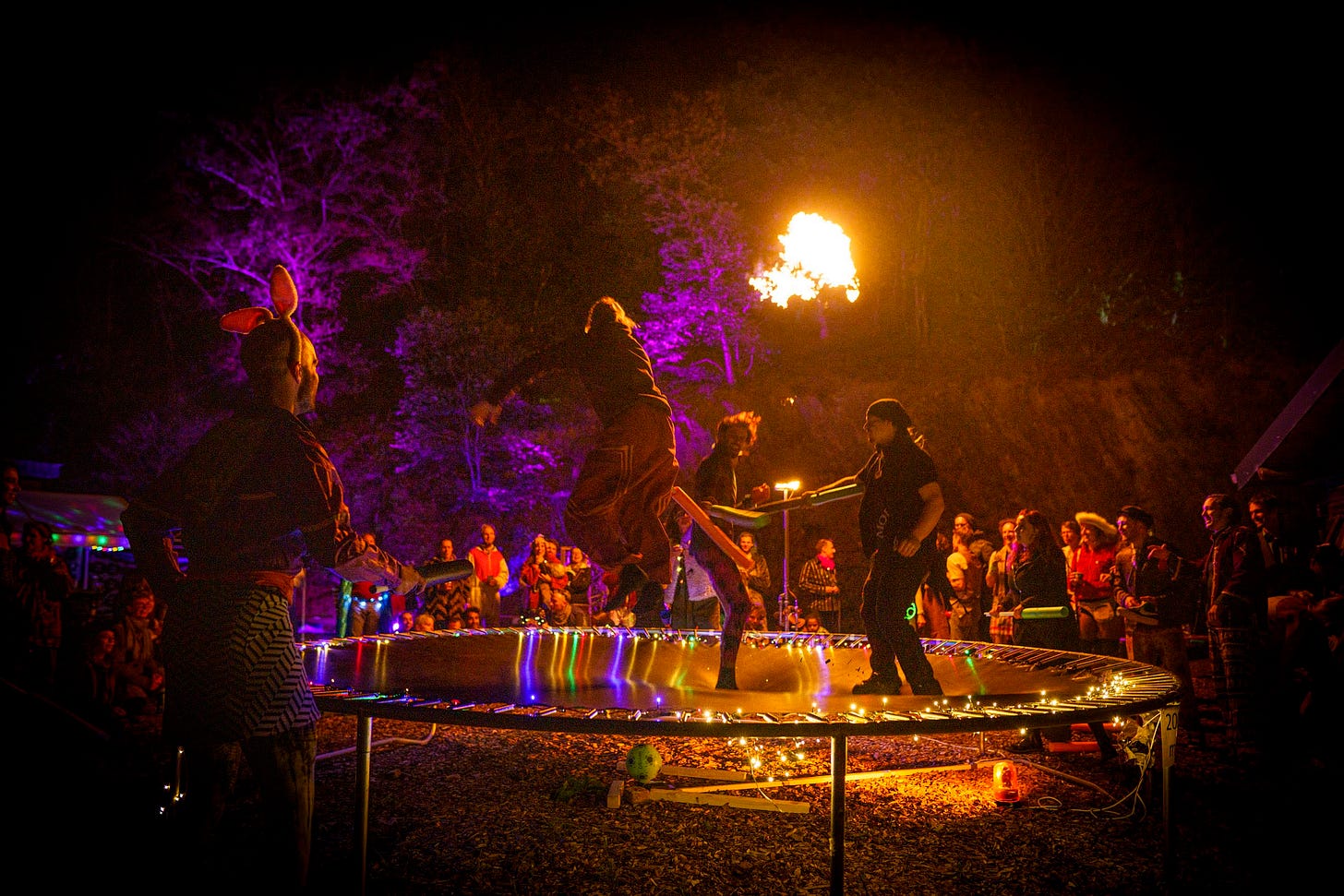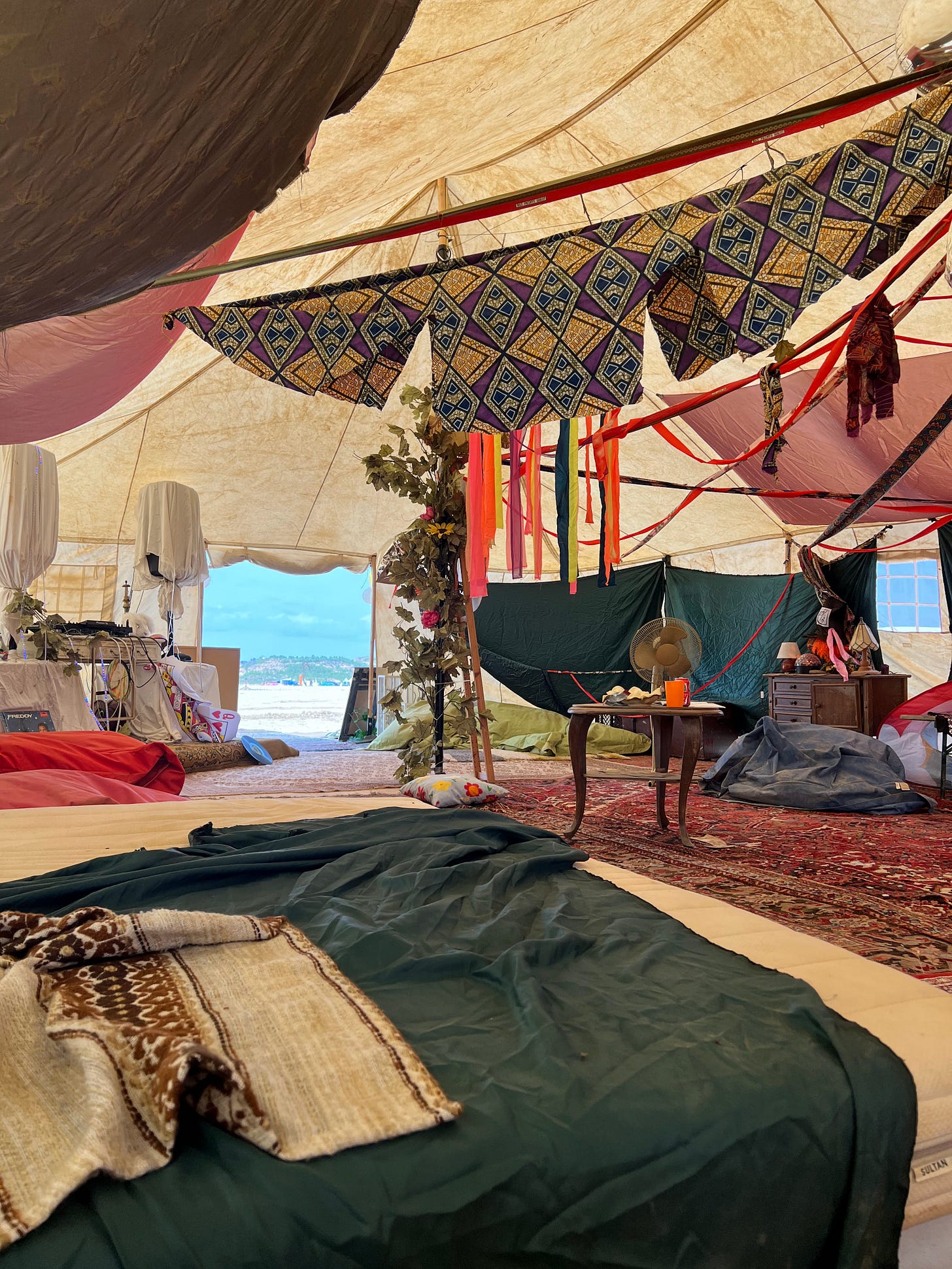How do you design a commune to maximise play? Isn’t that a conradiction - the structure of designign a space and the freedom of play?
The community that most embodies play to me is the Burning Man community. I attended Burning Man in 2016 and immediately felt home, felt free, felt playful, curious, creative. I climbed art sculptures, had a pillow fight, took workshops on topics I didn’t know existed, talked with strangers, danced until sunrise, relaxed in an airplane, cried at a temple, and was mesmerised by the flames of burning sculptures. I thought “if humanity can create spaces like this, then we’ll be fine.” But in my head I compartmentalised this to “Burning Man Energy”, got on with my life, and it became an idealised memory of something unattainable.
Until in 2019, I discovered and attended Nowhere, a burn in Spain, and was surprised to feel that although this is only 10% the size, and although this is on the different side of our planet, it felt exactly the same. And then again at AfricaBurn, and at some smaller burns in Europe, some only 200 people. No matter where - it always felt like an adult playground.

This of course begs the question: What’s the magic formula here? How do you design spaces to inspire playfulness, creativity, exploration? Of course, I don’t have the answer, but if I were to summarise my experience in two words, those would be:
Structured Chaos
When we play, we always have some ground rules we follow. A board game has explicit rules, as children our play is structured by our parents, music and dance each follow set structures and even the game of life is bound by our physical needs.
For burns, the structure is always the same
A set of ground rules to create the space: Burning Man has their famous 10 principles designed to get everybody in the same mindset: To play responsibly. For example they state that there is no money, everybody gifts their contributions to others. You are expected to radically self-express, to radically include others, to be in the moment, to participate.
A structured calendar: Building the event beforehand, an opening night with ceremonies, one massive party on Friday, a quiet night on Saturday, a few days of “strike” to tear down everything again and a few days of “decompression” in nature afterwards. Each day is similarly structured, often starting with a “morning circle” with the camp, workshops during the day, a joint dinner, and party at night.
Lots of unstructured time: While there is a high-level calendar serving as a scaffold, I wake up every day again and, after a first coffee, check in with myself and see what I feel like doing. There really is no need to be anywhere or to do anything, except for the odd shift, and this creates the freedom to let go and play.
Everybody contributes: To me, this is what makes burns so special. Everybody attending a burn will be involved with creating it in some way - by helping with the organization, by taking shifts during the event, by offering a workshop, by bringing art, or by staying sober during a party and watching out for people. This creates a richness that is different from anything I have seen before.
Removing all distractions: There are no commercial transactions at burns. People naturally organise in smaller communities to share the logistics of food, shade, and accomodation. Most people switch off their phones for the week. Everything is structured to just be present without having to worry about anything.
Setting all this structure up beforehand allows everybody to fully trust in the structures and let go in the moment. Basic needs are met, there is lots ot explore, and we all agree jointly to let go and play. This is when the magic happens, the chaos within the structure.

Structuring play in a commune
So what can we learn from this for designing a more permanent commune? Some have tried to take all these principles and make a permanent burn, and I’m sure it can be done, but similar to the post on spirituality I’d love for play to only be one element, not the central focus. I think the best way to achieve this is to apply the same principles on a smaller scale:
A set of ground rules to create the space: Consciously agreeing with the commune how we want to play. We could take inspiration from the 10 rules of Burning Man but this could also be about seeing what everybody’s needs are for play and defining rules from scratch.
A structured calendar: Calendars for festivities have been in our cultures forever, so let’s build on this. Maybe we celebrate the founding of the community, we host monthly parties, or movie nights every Wednesday. Having time dedicated to this makes sure we always make room to play and have something to look forward to.
Lots of unstructured time: Leave room for serendipidy. Some of the best times I had at the communities I stayed with where parallel play: Just sitting next to each other and all engaging in separate activities, without the expectation to engage, but with the option to.
Everybody contributes: Doing things together creates community. We already explored this in the post on making friends. At Selgars I co-organised extatic dance events and dinners and doing it together was so much more fun than if I would’ve done it alone. It also allowed me to fully enjoy things other members organised without feeling guilty for not having contributed.
Removing all distractions: A commune is a lot less detached from reality than a burn but small things like leaving phones at the door, preparing food before, or having a clear opening and closing of the event can all help to be more present.
Some of my best memories of play during my living in communities all followed some of these elements: Themed dinners, game nights, playful workshops, walks in nature, or just lazy evenings hanging out. I’d love for my ideal commune to create the space for an adult playground without losing sight of the other elements of the Wheel of Life and I hope that this will give some inspiration on how to get there.



ah structured chaos, my favorite kind of chaos!